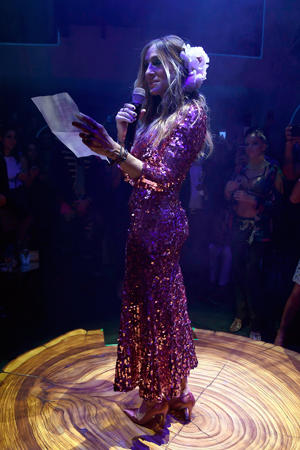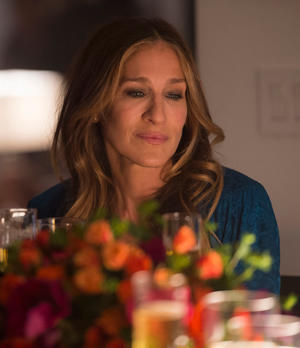Trending
Sarah Jessica Parker steps out
The actress is back on HBO, exploring the end of a marriage in her new series ‘Divorce’

There is snow on the ground in HBO’s “Divorce,” the network’s chilly but honest drama depicting the death of a marriage. Sheets of ice float down the Hudson as the relationship between Francis (played by Sarah Jessica Parker) and Robert (Thomas Haden Church) melts away. For the more than 800,000 Americans who separate from their spouses each year, these are familiar motifs. Divorce is a tundra — frozen and empty, vast and unexplored.
The show’s mise-en-scène is at times reminiscent of the icy Nordic backdrops of art house director Ingmar Bergman, whose emotional 1977 film and miniseries “Scenes from a Marriage” was blamed for spiking Sweden’s divorce rate.
Parker, who is also the show’s executive producer, says the nod to Bergman was intentional but that her show is more buoyant than many of the dark relationship dramas of the 1970s.
“There have been lots of television shows about families and marriage,” Parker told LLNYC during an interview days before the conclusion of the first season of “Divorce.” Season two will shoot in February. “I knew HBO told stories in a different way, and I was very interested in exploring the truth of a marriage.”
“Divorce” is Parker’s return to a starring role on television after more than a decade, and it’s already earned her a Golden Globe nomination.
Parker’s creative ensembles on “Sex and the City” helped establish her as style icon. Bradshaw’s bold fashion sense — mixing high and low, couture with her gold “Carrie” nameplate necklace — had a lasting impact on the way women dress in New York. And Parker’s spotlight on fashion broadened the reach of many designers. Take her predilection for Manolo Blahniks on the show, which introduced the brand to a new audience.
Parker embraces the speed and chaos
of shooting an episode a week
on single camera.
“Before ‘Sex and the City,’ we were sort of known as the Park Avenue [or] a Fifth Avenue ladies’ shoe brand. But ‘Sex and the City’ brought a much more aspirational woman,” George Malkemus III, Parker’s longtime friend and business partner as well as CEO of the iconic Manolo Blahnik brand, told LLNYC. “I would get into taxicabs and tell them to take me to 31 West 54th Street, the Manolo Blahnik townhouse, and Pakistani cab drivers would see the sign and say, ‘Oh my god! Carrie Bradshaw! Carrie Bradshaw! Sex and the City! Sex and the City!’ It was a whole new customer.”
But Parker says her new character is in no way an attempt to rebrand or disconnect from her “Sex and the City” days.
“I have never felt the burden of the association with Carrie Bradshaw,” Parker says. “I always felt it was a privilege for me. It has allowed me to play this person, tell a story that I love, and work with people in a city I love.”
Since putting away Bradshaw’s pumps with the 2010 feature film “Sex and the City 2,” Parker has continued to work at a determined pace. She’s appeared in four feature films, expanded her production company with partner Alison Benson at HBO, designed a retail line of shoes, fragrances and little black dresses with Malkemus, joined the board of the New York City Ballet and lent her star power to numerous philanthropic efforts. She’s also a wife, married to actor Matthew Broderick, and mother of three children, seven-year-old twins and a 14-year-old.

Parker read W. H. Auden’s poem “At Last the Secret Is Out” at Art Basel Miami. Then with a smile and a toast, she was gone.
Parker and Malkemus recently opened their first brick-and-mortar store for the SJP line of shoes and little black dresses outside Washington D.C. through a partnership with MGM. And despite the major corporate backing, Malkemus says Parker is personally involved in the minutiae of the shop, arranging clothes herself and even donating a hat right off her head to improve a mannequin’s style.
For Parker, “Divorce” came together after years of watching friends and family separate, and an interest “in exploring the truth of a marriage.” But when it was first pitched to HBO, she wasn’t planning to star.
“We weren’t developing this show for me, so I wasn’t trying to create a character that was different,” Parker says. However, she does acknowledge the stark contrast between Francis and Bradshaw.
“[Francis] is different in every way from Carrie Bradshaw. They only thing that is similar is that we look alike. Everything else is different. I look like Francis and Francis looks like Carrie. But it wasn’t a specific attempt to prove to everybody that I can do this different thing. I just loved this character.”
Still, like Bradshaw, Francis may prove to be a relatable archetype of modern womanhood for the millions of women struggling in their romantic lives. Like a portion of the original audience of “Sex and the City,” Parker’s character has grown up, fallen in love, made mistakes and seen it all disintegrate.
“It has been wonderful to play someone who just happens to be very different than Carrie Bradshaw,” Parker said.
***
During the first days of December, Parker was invited to do a reading at Art Basel Miami. At 10:30 p.m. she arrived at L’Eden, a temporary nightclub created for the festival by Perrier-Jouët and The Box’s Simon Hammerstein. In satin SJP Collection pumps, she climbed atop a massive tree stump at the center of the room’s atrium and read W. H. Auden’s poem “At Last the Secret Is Out” for the audience. Then with a small smile and a toast, she was gone. Parker says she was back at work in NYC at 8 a.m. the next day.
“I had never been to Art Basel,” Parker says, noting no particular interest in the raucous festival either. Parker isn’t an art investor or “collector,” although she does accumulate pieces that she finds interesting, sometimes even paintings on cardboard found on the street.
“There are other ways of seeing art, not just at the busiest time in Miami,” she told a reporter after leaving the stage at Art Basel. “One can travel to lots of places in our country and learn more about emerging artists and, obviously, established artists.”
Her poetry reading at Art Basel aside, Parker says she “doesn’t have a relationship with poetry” — beyond perusing the odd iamb in The New Yorker. She does claim to read a large number of novels, and has managed to turn even her pleasure reading into a side career.

Like a portion of the audience of “Sex and the City,” Parker’s new character has grown up, fallen in love, made mistakes and seen it all disintegrate.
Parker is currently in pursuit of the first novel to be published under her new literary fiction imprint, SJP for Hogarth. And she says a daunting number of manuscripts are currently piling up.
“I’m looking for strong, character-driven books,” she says. “I like global voices, books written by authors from Ireland, Nigeria, Korea or Russia. Those books are of particular interest to me, but there are no criteria as we pursue this first manuscript. We are just looking for powerful, singular voices in the literary fiction space.”
She points to Anthony Marra’s “A Constellation of Vital Phenomena,” the story of a young girl caught in the violence of postwar Chechnya, as a standard for what she hopes to achieve as a publisher.
“She is the master of juggling many different businesses,” Benson says, noting that Parker is also producing several shows and documentaries at HBO.
Parker says she feels at home in the eye of the storm. Television, especially, is a homecoming for Parker, and she embraces the speed and chaos of shooting an episode a week on single camera.
“I like the limitation of time. It just makes you work really efficiently. There is an urgency to it,” she says. “There is no bloated schedule. There is no sitting around and waiting. You are really about making the day every single day … the work becomes the focus.”
Like so many actors, Parker says she is enjoying the freedom that the so-called New Golden Age of Television has created for long-form storytelling. The ability to explore the nuances of a character over dozens of episodes, seasons, years, is something few actors of the past enjoyed.
“It’s the opportunity to tell the story of a life,” Parker says. “I got to play a character on ‘Sex and the City’ for basically 12 years. I lived a whole other life. In some instances I spent more time being that person than myself. So it is a very interesting exercise, and an investigation of a whole other person. For someone like me, who is very curious, it’s a thrill.”
***
Today, Parker might be Ms. Manhattan. But she was born in Nelsonville, Ohio. Her parents divorced when she was an infant. Her mother remarried a Brooklynite, and in 1977 they moved to New York City, in part to help Parker train as a performer.
“I got to play a character on ‘Sex and the City’
for basically 12 years … In some instances
I spent more time being that person than myself.”
They were some of the first residents to move to Roosevelt Island after it was redeveloped. They were poor. It was the time many New Yorker’s call “the bad old days,” but Parker says she remembers those years fondly.
“It was fantastic,” she says. “We didn’t have any money, but we were living in a city that we loved. We were going to the theater when we could afford it, and going to museums and taking the subway. We were surrounded by things that were interesting to us. New York in the late ’70s, people talk about it being dangerous. It was really an exciting place to be. There are things about that time in New York that I miss very much actually.”
Nostalgia comes easy in a city like New York, where not only the people but the buildings ebb and flow. The city isn’t transformed; it’s ever transforming toward a pinnacle of affluence it can never quite seem to reach. It’s believed that the first $1 million sale of a Manhattan apartment occurred in 1978 (not long after the Parker family’s move). The average apartment price now exceeds $2 million in Manhattan. Institutions, landmarks and small businesses are lost as opulent sky palaces rise around Central Park. The city is increasingly splendid and safe, and in direct proportion mundane.
Parker moved to Greenwich Village in 1991. Her husband of nearly 20 years was born and raised there. Last year the couple paid $34.5 million for two adjacent townhouses on West 11th Street, likely with the intention of combining the homes to create a 50-foot-wide, 13,900-square-foot mansion. While this may seem like just the sort of activity that has deprived Manhattan of so much of its erstwhile character, Parker says she and her husband are deeply invested in keeping the Village alive.

Parker last spring at the 68th annual Parsons School of Design Benefit, which honors fashion icons and raises funds for scholarships.
“We mourn the changes in lots of ways,” Parker says. “We mourn the way the color of our neighborhood changed. It was a neighborhood that was populated by immigrants. There was a lot of affordable housing and rent-stabilized and [rent-]controlled apartments. It wasn’t such a magnet for developers. It was much more diverse. I think it has been very hard for that community.”
Still, Parker admits she doesn’t know how to roll back the effects of gentrification in a neighborhood where relatively wealthy families are routinely pushed out, where homes cost tens of millions. She says she is actively involved in working with elected officials to create space for small businesses in the neighborhood.
“Part of it is just a process taking place in cities around our country,” she says, adding that the changes negatively impact everyone. “You lose services. You lose stores and shoe repairs and the things that make a community thrive … I don’t really know how you undo all that. I don’t think all landlords are monsters or villains, but it is hard to see a neighborhood lose some of the vitality that comes with diversity. It is not good for us. The beauty of living in a place like New York is experiencing. Our children take the subway and buses, and they see all sorts of different people, and we want that for them.”
But Parker isn’t just concerned about the loss of shoe repair shops in Greenwich Village, Manhattan or even New York City. With the election of Donald Trump, Parker feels that much more could be on the line and that people need to continue struggling for progress.
“Like many Americans, I am now wondering how to direct my passions. How do I direct my energy, be an advocate for working women, or make sure that we are thinking about access to healthcare for everybody, the pay gap, equality, the climate, all sorts of things that we hoped would be addressed?”
Even as those to the left of Trump prepare for the worst, Parker remains hopeful that people will come together as members of a community and find common ground, while not abandoning the struggle for universal childcare and women’s healthcare.
“I don’t come to this as a celebrity or someone who is telling anybody how to think. I come to this as a civilian. I grew up in a family that has always been involved in local, city, state and federal elections,” Parker says, noting her first exposure to politics was campaigning for George McGovern. “I will always be that person because that was how I was raised. I was told that I had a responsibility.”
***
It’s not just Parker’s character who has changed with “Divorce,” it’s who is watching her.
Parker’s career has largely been followed and celebrated by woman and gay men. But as the audience for “Divorce” grew, Parker says she was surprised to discover that so many single men were watching her.
“We assumed that the audience was the generation of women who watched ‘Sex and the City’ and are now in relationships, and therefore we could bring them in,” Parker says.
But the first week the show aired, reports showed 55 percent of the audience was male. Parker says that now it is evenly split.
“There is a high male viewership, which we never had for ‘Sex and the City,’ Parker says. “I think it’s because it’s the story of a marriage and it’s archetypal in some ways of an American marriage. It deals with obstacles that are familiar to a lot of American families. The economic crisis that hit in 2008 is something that we talk about.”
“It has been so exciting to see our numbers grow every week, which is all you can hope for. The show is very amusing and funny, and people behave in ridiculous ways. There is also a lot of truth and pathos and rawness to the show. And the fact that it hasn’t been a turnoff is a huge relief.”
But despite the prototypical nature of the narrative, Parker says that working on the show opened her eyes to an unfamiliar aspect of divorce that she finds reassuringly sanguine.
“I’ve learned one thing. I find it ironic that the very attempt of separating requires the other person more than ever,” she says. “I think people don’t get that. They think you are getting away and liberating yourself from this person, but in order to do so you actually need the other person to collaborate possibly more so than you have in years. I think that is why it is so challenging for people. It’s asking the best of you at the worst time, and when you are least inclined to be conciliatory or compromise is when you most have to do it.”
With a new show, new absorbing character, new audience, and new businesses, Parker is in uncharted territory, but what comes next, she says, is much more certain: more work, possibly until she drops dead.
“Well, Ruth Gordon did!” Parker laughs, referring to the “Rosemary’s Baby” and “Harold and Maude” actress who was working on her latest play the day she died. “I am a person who loves to work. I love being a mother, and I love working outside the home. If I can be bold enough to say what I hope for, I would say more of the same. I hope that I have worked hard enough to be deserving of more opportunities. And that’s more than anybody dare say out loud.”




